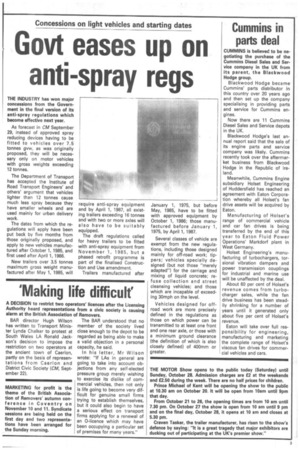Govt eases up on anti-spray regs
Page 5

If you've noticed an error in this article please click here to report it so we can fix it.
THE INDUSTRY has won major concessions from the Government in the final version of its anti-spray regulations which become effective next year.
As forecast in CM September 29, instead of approved spray reducing devices having to be fitted to vehicles over 7.5 tonnes gvw, as was originally proposed, they will be necessary only on motor vehicles with gross weights exceeding 12 tonnes.
The Department of Transport has accepted the Institute of Road Transport Engineers' and others' argument that vehicles lighter than 12 tonnes cause much less spray because they have smaller wheels and are used mainly for urban delivery work.
The dates from which the regulations will apply have been put back by five months from those originally proposed, and apply to new vehicles manufactured after October 1, 1985, and first used after April 1, 1986.
New trailers over 3.5 tonnes maximum gross weight manufactured after May 1, 1985, will require anti-spray equipment and by April 1, 1987, all existing trailers exceeding 16 tonnes and with two or more axles will also have to be suitably equipped.
The draft regulations called for heavy trailers to be fitted with anti-spray equipment from November 1, 1 98 5, but a phased retrofit programme is part of the finalised Construction and Use amendment.
Trailers manufactured after January 1, 1975, but before May, 1985, have to be fitted with approved equipment by October 1, 1986; those manufactured before January 1, 1975, by April 1, 1987.
Several classes of vehicle are exempt from the new regulations, including those designed mainly for off-road work; tippers; vehicles specially designed (but not those "merely adapted") for the carriage and mixing of liquid concrete; refuse collection and street cleansing vehicles; and those which are incapable of exceeding 30mph on the level.
Vehicles designed for offroad work are more precisely defined in the regulations as those on which power can be transmitted to at least one front and one rear axle, or those with a minimum ground clearance (the definition of which is also closely defined) of 400mm or greater.
































































































































































































































